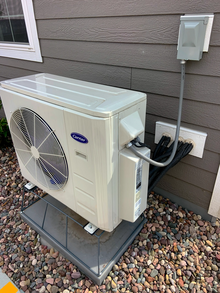
Back مضخة حرارية Arabic Wärmepumpn BAR Термопомпа Bulgarian Toplotna pumpa BS Bomba de calor Catalan Tepelné čerpadlo Czech Varmepumpe Danish Wärmepumpe German Αντλία θερμότητας Greek Varmopumpilo Esperanto


| Part of a series on |
| Sustainable energy |
|---|
 |
A heat pump is a device that uses energy (usually electricity) to transfer heat from a colder place to a warmer place. Specifically, the heat pump transfers thermal energy using a heat pump and refrigeration cycle, cooling the cool space and warming the warm space.[1] In winter a heat pump can move heat from the cool outdoors to warm a house; the pump may also be designed to move heat from the house to the warmer outdoors in summer. As they transfer heat rather than generating heat, they are more energy-efficient than heating by gas boiler,[2] and also good for cooling a home.[3]
A gaseous refrigerant is compressed so its pressure and temperature rise. When operating as a heater in cold weather, the warmed gas flows to a heat exchanger in the indoor space where some of its thermal energy is transferred to that indoor space, causing the gas to condense to its liquid state. The liquified refrigerant flows to a heat exchanger in the outdoor space where the pressure falls, the liquid evaporates and the temperature of the gas falls. It is now colder than the temperature of the outdoor space being used as a heat source. It can again take up energy from the heat source, be compressed and repeat the cycle.
Air source heat pumps are the most common models, while other types include ground source heat pumps, water source heat pumps and exhaust air heat pumps.[4] Large-scale heat pumps are also used in district heating systems.[5]
The efficiency of a heat pump is expressed as a coefficient of performance (COP), or seasonal coefficient of performance (SCOP). The higher the number, the more efficient a heat pump is. For example, an air-to-water heat pump that produces 6kW at a SCOP of 4.62 will give over 4kW of energy into a heating system for every kilowatt of energy that the heat pump uses itself to operate. When used for space heating, heat pumps are typically more energy-efficient than electric resistance and other heaters.
Because of their high efficiency and the increasing share of fossil-free sources in electrical grids, heat pumps are playing a role in climate change mitigation.[6][7] Consuming 1 kWh of electricity, they can transfer 1[8] to 4.5 kWh of thermal energy into a building. The carbon footprint of heat pumps depends on how electricity is generated, but they usually reduce emissions.[9] Heat pumps could satisfy over 80% of global space and water heating needs with a lower carbon footprint than gas-fired condensing boilers: however, in 2021 they only met 10%.[5]
- ^ "Heat Pump Systems". Energy.gov. Retrieved 26 March 2024.
- ^ "Gas boiler vs heat pump: which is right for you? - British Gas". www.britishgas.co.uk. Retrieved 18 January 2025.
- ^ "Heat Pump Systems". US Department of Energy. Archived from the original on 27 April 2023. Retrieved 27 April 2023.
- ^ "Exhaust air heat pumps". Energy Saving Trust. Retrieved 22 February 2024.
- ^ a b Technology Report: The Future of Heat Pumps. International Energy Agency (Report). November 2022. Archived from the original on 6 January 2023. Retrieved 6 January 2023. License: CC BY 4.0.
- ^ IPCC AR6 WG3 Ch11 2022, Sec. 11.3.4.1.
- ^ IPCC SR15 Ch2 2018, p. 142.
- ^ Everitt, Neil (11 September 2023). "Study proves heat pump efficiency at low temperatures". Cooling Post. Retrieved 22 January 2024.
- ^ Deetjen, Thomas A.; Walsh, Liam; Vaishnav, Parth (28 July 2021). "US residential heat pumps: the private economic potential and its emissions, health, and grid impacts". Environmental Research Letters. 16 (8): 084024. Bibcode:2021ERL....16h4024D. doi:10.1088/1748-9326/ac10dc. ISSN 1748-9326. S2CID 236486619.